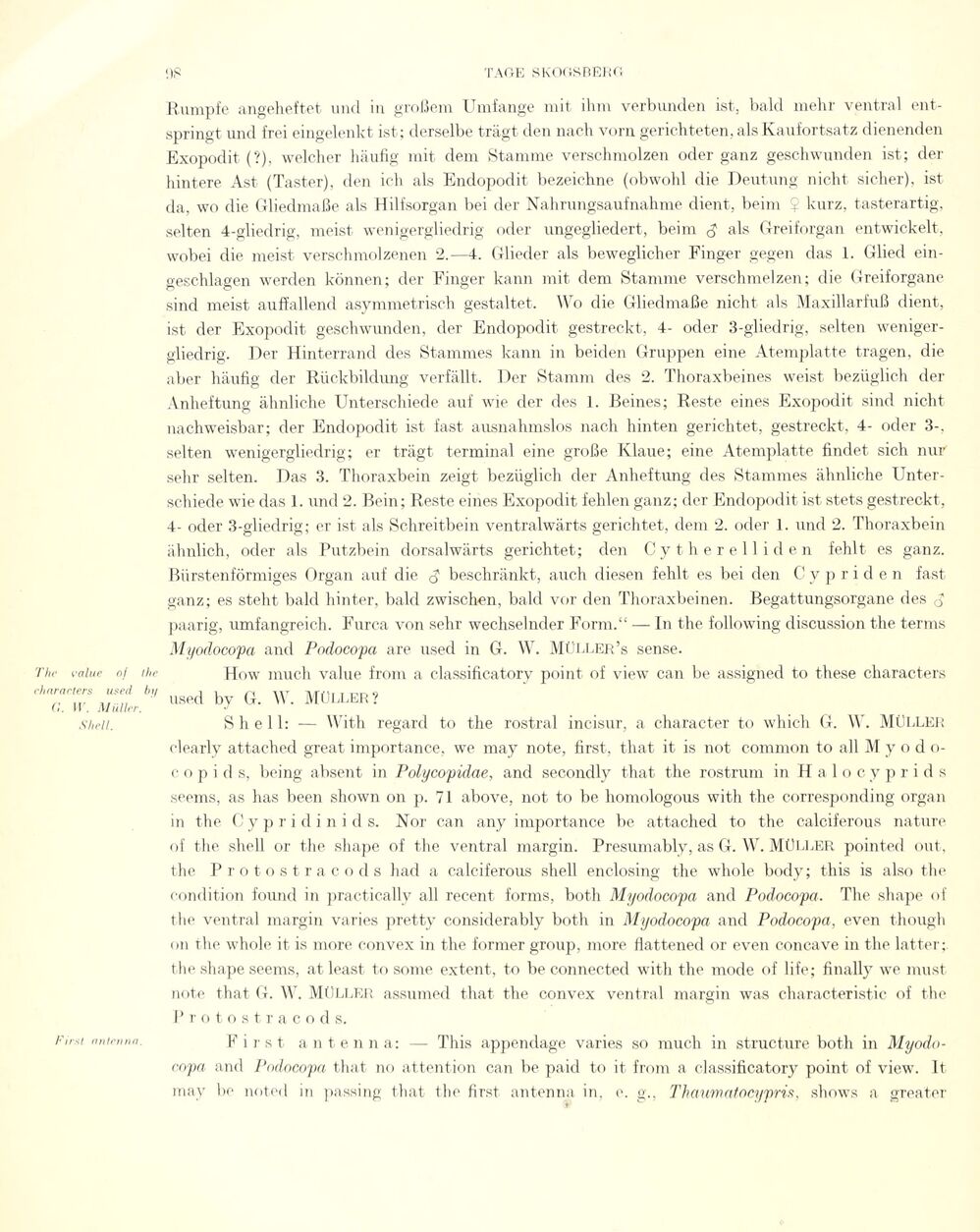
Full resolution (JPEG) - On this page / på denna sida - Sidor ...

<< prev. page << föreg. sida << >> nästa sida >> next page >>
Below is the raw OCR text
from the above scanned image.
Do you see an error? Proofread the page now!
Här nedan syns maskintolkade texten från faksimilbilden ovan.
Ser du något fel? Korrekturläs sidan nu!
This page has never been proofread. / Denna sida har aldrig korrekturlästs.
The value aj the
characters used by
C. M\ Müller.
Shell.
First antenna.
Rumpfe angeheftet und in großem Umfange mit ihm verbunden ist, bald mehr ventral
entspringt und frei eingelenkt ist; derselbe trägt den nach vorn gerichteten, als Kaufortsatz dienenden
Exopodit (?), welcher häufig mit dem Stamme verschmolzen oder ganz geschwunden ist; der
hintere Ast (Taster), den ich als Endopodit bezeichne (obwohl die Deutung nicht sicher), ist
da, wo die Gliedmaße als Hilfsorgan bei der Nahrungsaufnahme dient, beim Ç kurz, tasterartig,
selten 4-gliedrig, meist wenigergliedrig oder ungegliedert, beim d als Greiforgan entwickelt,
wobei die meist verschmolzenen 2.—4. Glieder als beweglicher Finger gegen das 1. Glied
eingeschlagen werden können; der Finger kann mit dem Stamme verschmelzen; die Greiforgane
sind meist auffallend asymmetrisch gestaltet. Wo die Gliedmaße nicht als Maxillarfuß dient,
ist der Exopodit geschwunden, der Endopodit gestreckt, 4- oder 3-gliedrig, selten
wenigergliedrig. Der Hinterrand des Stammes kann in beiden Gruppen eine Atemplatte tragen, die
aber häufig der Rückbildung verfällt. Der Stamm des 2. Thoraxbeines weist bezüglich der
Anheftung ähnliche Unterschiede auf wie der des 1. Beines; Reste eines Exopodit sind nicht
nachweisbar; der Endopodit ist fast ausnahmslos nach hinten gerichtet, gestreckt, 4- oder 3-,
selten wenigergliedrig; er trägt terminal eine große Klaue; eine Atemplatte findet sich nur
sehr selten. Das 3. Thoraxbein zeigt bezüglich der Anheftung des Stammes ähnliche
Unterschiede wie das 1. und 2. Bein; Reste eines Exopodit fehlen ganz; der Endopodit ist stets gestreckt,
4- oder 3-gliedrig; er ist als Schreitbein ventralwärts gerichtet, dem 2. oder 1. und 2. Thoraxbein
ähnlich, oder als Putzbein dorsalwärts gerichtet; den Cytherelliden fehlt es ganz.
Bürstenförmiges Organ auf die beschränkt, auch diesen fehlt es bei den C y p r i d e n fast
ganz; es steht bald hinter, bald zwischen, bald vor den Thoraxbeinen. Begattungsorgane des
paarig, umfangreich. Furca von sehr wechselnder Form.“ — In the following discussion the terms
Myodocopa and Podocopa are used in G. W. Müller’s sense.
How much value from a classificatory point of view can be assigned to these characters
used by G. W. MÜLLER?
Shell: — With regard to the rostral incisur, a character to which G. W. MÜLLER
clearly attached great importance, we may note, first, that it is not common to all M y o d
o-c o p i d s, being absent in Polycopidae, and secondly that the rostrum in H a 1 o c y p r i d s
seems, as has been shown on p. 71 above, not to be homologous with the corresponding organ
in the Cypridinids. Nor can any importance be attached to the calciferous nature
of the shell or the shape of the ventral margin. Presumably, as G. W. MÜLLER pointed out,
the Protostracods had a calciferous shell enclosing the whole body; this is also the
condition fourni in practically all recent forms, both Myodocopa and Podocopa. The shape of
the ventral margin varies pretty considerably both in Myodocopa and Podocopa, even though
on the whole it is more convex in the former group, more flattened or even concave in the latter;
the shape seems, at least to some extent, to be connected with the mode of life; finally we must
note that G. W. MÜLLER assumed that the convex ventral margin was characteristic of the
Protostracods.
First antenna: — This appendage varies so much in structure both in
Myodocopa and Podocopa that no attention can be paid to it from a classificatory point of view. lt
may be noted in passing that the first antenna in. e. g., Tkaumatocypris, shows a greater
<< prev. page << föreg. sida << >> nästa sida >> next page >>